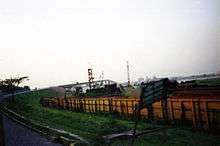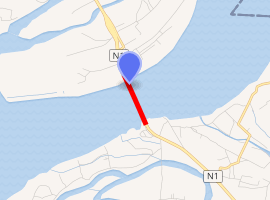Meghna Bridge
Meghna Bridge is a road bridge in Bangladesh.[1] It was built with the assistance of Japan and officially named Japan Bangladesh Friendship Bridge 1, but it is popularly known as Meghna Bridge.[2] According to a study conducted in 2004 by the Embassy of Japan in Bangladesh, residents living around the Meghna Bridge recognized several positive impacts after the construction of the bridge.[3]
Meghna Bridge | |
|---|---|
 | |
| Coordinates | 23°36.162′N 90°36.991′E |
| Carries | Motor vehicles and pedestrians |
| Crosses | Meghna River |
| Locale | Bangladesh |
| Official name | Japan Bangladesh Friendship Bridge 1 |
| Characteristics | |
| Design | Cantilever bridge |
| Material | Prestressed concrete |
| Total length | 900 metres (2,952 ft 9 in) |
| Width | 9.2 metres (30 ft 2 in) |
| Longest span | 87 metres (285 ft 5 in) |
| History | |
| Constructed by | Nippon Koei Co. Ltd [1] |
| Opened | February 1, 1991 |

| |
Location
Meghna Bridge is 30 kilometres (19 mi) southeast of Dhaka[2] across the Meghna River,[4][5] which is one of the major rivers in the country.[4] The bridge is located along the Dhaka–Chittagong Highway.[2] The geographic coordinate of the Meghna Bridge is 23°36.162′N 90°36.991′E.[4]
History
Meghna Bridge was built with the financial help from the Government of Japan.[6][7] It was constructed by the Nippon Koei Co. Ltd.,[1] (an independent engineering consulting firm in Japan that has been involved in projects in more than 80 countries).[8] The bridge was opened on February 1, 1991.Meghna Bridge is the single largest project with Japanese assistance in the world.[9]
In 2005, the bridge underwent extensive repair because the expansion joints of the bridge were damaged due to the lack of appropriate maintenance.[6]
Architecture
Meghna Bridge is a cantilever[1] and girder bridge. It is 930 metres (3,051 ft 2 in) in length with dual carriageway and 9.2 metres (30 ft 2 in) in width. The bridge has thirteen spans. Two among the individual spans are of 24.25 metres (79 ft 7 in) in length each, one is of 48.3 metres (158 ft 6 in) in length, nine spans are of 87 metres (285 ft 5 in) in length each and the length of the rest is 18.2 metres (59 ft 9 in). The carriage way of the bridge is 7.2 metres (23 ft 7 in). The foundations are supported on RCC caissons and piles. Piled foundation of abutments are buried. RCC caissons which are used as foundation under the piers are also buried. Both abutments and the piers of the bridge are RCC solid type.[10] The piers of the bridge are hexagonal. Each pier is of 11 metres (36 ft 1 in) in length and 3.2 metres (10 ft 6 in) in width.[4]
The wing walls of the bridge are of RCC and are fixed with abutments and have no weep holes. Railing type of the bridge is of R.C.C post and steel rail. The bridge has 0.80 metres (2 ft 7 in) wide sidewalk at both sides. Meghna Bridge also has infrastructure of drainage.[10]
Economic impact
Traffic volumes across the Meghna River and of National Highway No. 1 significantly increased after the opening of the Meghna Bridge. In April 1997, an average of 10,149 vehicles of all types used the bridge in each 24 hours while March 2004 saw 9,704 vehicles per day. The reason behind this fall in traffic volume is attributed to increase in toll rate in 2002 and seasonal fluctuations.[3] Below is a comparison of vehicles using the bridge per day in April 1997 and March 2004:
| Vehicle[3] | Truck[3] | Bus[3] | Light Vehicle[3] | Motorcycle[3] | Total[3] |
|---|---|---|---|---|---|
| April 1997 | 4,674 | 3,396 | 1,796 | 283 | 10,149 |
| March 2004 | 4,310 | 3,887 | 1,030 | 477 | 9,704 |
The survey conducted in 2004 by the Embassy of Japan in Bangladesh found that a majority of the users of the bridge believe that the construction of the Meghna Bridge improved the life of the people living near it and the surrounding area of the bridge has been urbanized. The people surveyed opined that the number of traffic blockage caused by bad weather has been decreased since the construction. The survey also found that 42% of the trucks using Meghna Bridge transport goods between Dhaka and Chittagong.[3]
References
- Meghna Bridge at Structurae
- Impact of major floods on the river morphology at the vicinity of bridges in Bangladesh
- The basic study on the present situation of the previous grant aid project for the bridges in Bangladesh Archived 2011-07-22 at the Wayback Machine Embassy of Japan in Bangladesh
- Morphological Characteristics Of The River Meghna: A Collaborative Study Archived 2005-05-25 at the Wayback Machine Water Resources Research Centre, Disaster Prevention Research Institute, Kyoto University
- Padma Multipurpose Bridge Design Project Archived 2009-02-06 at the Wayback Machine Asian Development Bank
- Ferry service on Dhaka-Ctg highway from Sept 10 The Daily Star
- Yen Loans for Constructing Access Roads to the Jamuna Bridge Archived 2005-11-24 at the Wayback Machine Japan Bank for International Cooperation
- Nippon Koei Co. Ltd. Archived 2006-07-16 at the Wayback Machine Engineering and Consulting Firms Association (ECFA), Japan
- Nagendra K. Singh (2003). Encyclopaedia of Bangladesh. Anmol Publications Pvt. Ltd. p. 293. ISBN 81-261-1390-1.
- Principal Bridge Inspection Report Roads and Highways Department, Ministry of Communications, Bangladesh